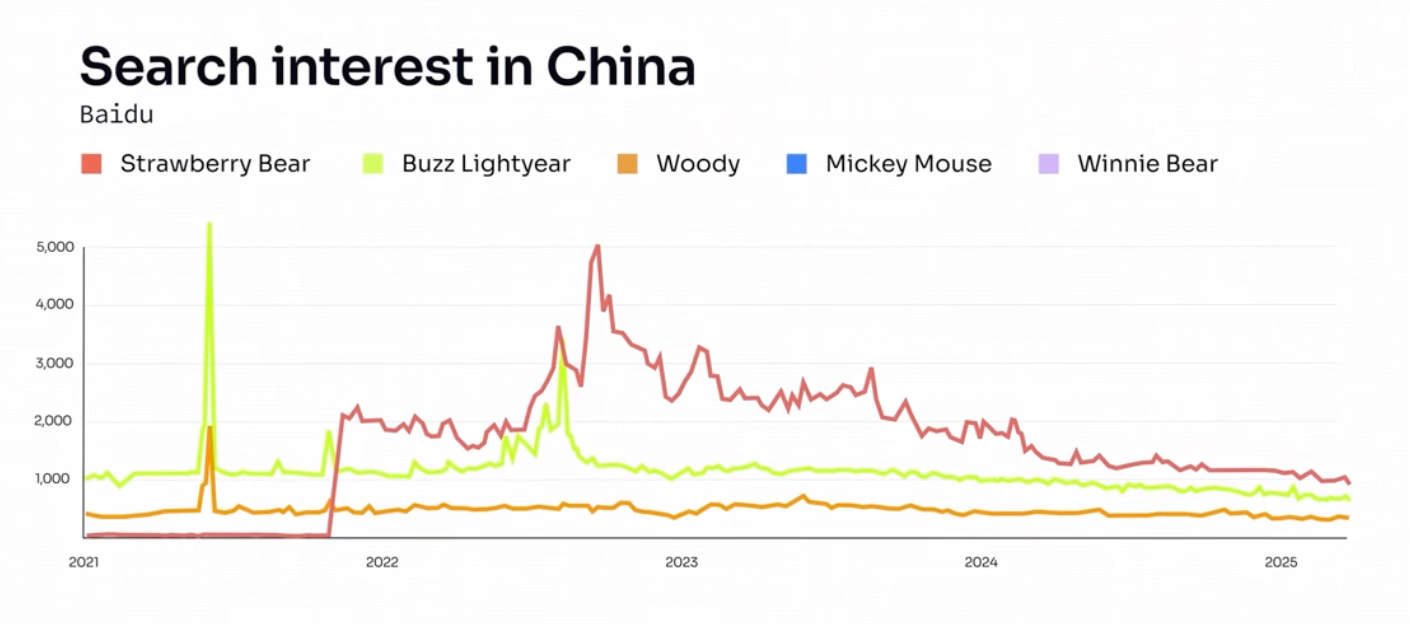The mystery of Lotso Bear's popularity in China: How I helped a video journalist uncover the story | Following the Yuan
What a strawberry-scented villain reveals about consumer trends in today's China. (You can watch the story on YouTube at the end.)
Key takeaways
Trend narratives that hook early adopters can differ significantly from those that appeal to the mass market. (In this case, it’s the difference between a villain and a cute bear that smells like strawberry.)
The power behind the central, top-down push of a trend is often ignored in trend analysis. However, it could be a key driver of mass adoption in China.
China research tips: beware of your bias, question the sources, keep reframing your questions and angles.
The process
When I was approached by Tunnel Vision about Lotso Bear. I was fairly confused.
The host and video journalist, Christophe, wondered why Lotso Bear, a side character from Toy Story, was popular in China. He received the request from an audience member who recently travelled to China for business, and the latter was stunned to see Lotso Bear everywhere.
As a video news show that dives deep into mysteries from all corners of the internet—including the Chinese internet—Christophe took it upon himself to find the answer. And he reached out to me.
I was only vaguely familiar with Toy Story, and although I see the bear everywhere but didn’t make the connection that it’s from the Disney movie. My impression was that it’s an innocuous purple bear that faded into the background. And I wondered: why not ask me about Disney’s Linabell, Jellycat, Pop Mart’s Labubu or other stuffed animals that are more on trend in China?

On second thoughts, I realized that maybe I’ve grown accustomed to it because it is everywhere, I’ve always been drawn to new trends while they’re developing, but rarely looked at how something goes from its original state to mass adoption. This is a good opportunity.
Given the frame of the question at that time, which is “how has Miniso made Lotso Bear so popular?” Here are my immediate hypotheses:
Many mass consumers like 'Strawberry Bear’ because it’s cute and smells good, not all have watched Toy Story
Miniso pays less IP fees for side characters
It also prefers safe, low-key IPs that are free from censorship, unlike Winnie the Pooh
The “emotional consumption” theory: Consumers are more prone to pay for emotional value post-COVID and in an economic downturn.
Top-down collaboration sparked industry followers
A key piece of information from Christophe is Miniso’s WeChat post in 2021, showcasing their first Lotso Bear collab.
When I took a look on Taobao, it becomes clear: the 2021 collaboration helped prove the popularity for other brands and manufacturers to follow suit. On the e-commerce site, there are more than two dozens of toy sellers selling ‘Strawberry Bear’ related merch. Bear in mind that there are many more illegit producers across the country that did not pay for IP fees.
At the same time, there were collaborations with EV brand Baojun, under SAIC-GM-Wuling Automobile, scooter brand Yadi, pastry brand Holiland, among others:



Many Chinese merchants are ingrained with the ‘trial-and-error’ process, they produce things in micro batches and test the market reception. The success of Miniso x Disney collab spared them from that investment. It’s basically saying: The concept is proven! Come copy it!
What makes Miniso so good at capturing popular IPs?
The strength of retail brand Miniso, now a global chain with over 7,000 stores, lies in their understand of Chinese trends. With experiences of short product cycles and trends in China, they are made aware that they could both positively and negatively surprises a business. So, their approach?
Throwing pasta against the wall and see what sticks, repeatedly. In corporate words, it is:
“Smooth out the trend cycles with the strategy of building an IP matrix, reduce the reliance on one single IP, and build relay batons of growth (通过 IP 矩阵平滑潮流周期,减少对单一形象的依赖, 打造出成长的接力棒),” said Ye Guofu, the founder and CEO of Miniso, at the company’s FY2024 earnings call. The Guangzhou-headquartered brand planned the launch of over 90 new IPs in the financial year.
It was only when three years after the initial launch that Disney Consumer Products, a Disney division that retails and licenses Disney IPs, started telling the world that it had been the mastermind behind Lotso’s popularity all along.

This reminds me of another corporate-driven beauty trend "Milllard style" (美拉德风), a term borrowed from food science to describe the browning reaction, that took off in the fall of 2023. Basically, ByteDance’s Douyin and several beauty brands, which were supposedly worried about the sales of their brown-toned products, linked up with influencers to make "Milllard" a thing. After the initial popularity on Douyin, it had spread to Rednote and also into fashion.

Before you go: “OUR WORLD IS CONTROLLED BY EVIL CORPORATIONS!” That’s not what I’m saying at all.
I don’t believe companies knew for sure their trials would catch on, hence the pasta-throwing.
Change in trend narratives
There’s also a pattern in trend adoption and mass communications that applies here: the narratives that hook early adopters and the mass majority can be very different. The latter usually follow after it becomes popular, and gives the trend a new narrative.
Before we talk more about what those narratives mean, let’s turn to the Chinese humanoid robot maker Unitree for a minute.
During this year’s national Spring Festival Gala, I was proud to be one of the first to shit about the dancing robots with flamboyant Dongbei print on RedNote, “Can someone tell me it’s a joke?” I posted while it was still showing. At that time, I saw about a dozen posts expressing similar sentiment. We could not believe that this was all internationally acclaimed director Zhang Yimou had come up with. I mean, see for yourself here.
However, within days, the sentiment shifted as state media churned out propaganda. It was now framed a huge success—celebrating both creative and technological heights on a national level. Forget green tea and West Lake, it has become the new symbol of Hangzhou.
Even I started wondering if I’d miss something crucial. Was I being too cynical?
The turn of this narrative could be caused by different things. I thought, just like how the narrative was turned in Unitree’s robots, what made Lotso bear ’Strawberry bear’ and part of the public discourse is not the origin story—how he was abandoned by his owner and became the primary villain in Toy Story—but how cute this purple, strawberry-scented bear is.
The mass audience can grasp one point straight away, you see. And that point should be simple enough when trend followers give it attention. That means a dancing robot that shows China’s world-leading technological prowess; a strawberry-scented teddy bear, which makes a perfect gift.
The simpler for them the better. Too much backstory doesn’t help.
China research tips
I was in awe when I finished watching the video—I’ve honestly decided that long explainers in the video form is the best way to tell China stories.
Because 1. visuals defy people’s stereotypical imagery of China; 2. many China things only happen in China, and it’d be hard to imagine based on texts; 3. the long-form format means things can be put into context and nuances are welcomed.
I also believe this is a great opportunity to pull back the curtains a bit, and show you the approach that guided us to the bottom of the question.
Beware of your bias
I really respect Christophe for not being afraid of reading translated versions of original Chinese source links, and downloading Chinese apps to search for key terms himself.
If you only look for answers on the platforms and in the mediums that Chinese people don’t use, you are not going to find your answers.
And I don’t mean to compare people but as an influential figure, this is something that Noah Smith is not aware of. He sees China videos on YouTube and be like: this is China! Where are the street-level views?! ‘The internet’ does not equal to the Chinese internet.

Question the sources and the information channels
This goes hand-in-hand with the first one—don’t trust non-credible sources on Google about China.
Christophe found a bunch of AI-generated articles trying to explain the trend, linking Lotso’s personality with traditional Chinese values, which is total nonsense. He questioned and investigated by using multiple AI content verifiers.


Put things into perspective with data over a fixed time. Here, beware of the limitations of the platform you’re using, the demographic of that platform, and the data points you’re leaving out.
While doing trend research in China, it’s a good idea to use a combination of public data from Baidu and RedNote. Because although Baidu has been the prominent search engine, increasingly, young consumers have found RedNote a better place for their less-censored, heartfelt answers. The latter platform, populated in the West by “Tiktok Refugees”, was also heavily focused on consumer goods and lifestyle.
For reference, here the hashtag search results on RedNote ft. popular cartoon characters and comparing to stats of Toy Story. As you can see, Strawberry Bear (Lotso’s widely used name in Chinese) was more popular than Toy Story.
#玲娜贝儿/Linabell: 5329M views, 20.6M posts
#草莓熊/Lotso Bear: 1173.1M views, 6.9M posts
#Jellycat: 2113M.3M views, 13.5M posts
#拉布布/Labubu: 190.5M views, 1.5M posts
#玩具总动员/Toy Story: 818.1M views, 3.5M posts
keep reframing your questions and angles
If you remember the question we started with, it was almost entirely focused on Miniso. But as we gathered new pieces of information, we kept reframing our angles—like examining a box from every side: horizontally, vertically, sideways, and eventually opening it up. It turns out that Christophe and I’s hypotheses are all valid, it’s a matter of which factor has played a larger role. And I believe it was Disney’s own initiative.
From trend data to statements in earnings call to interviews, this is how research and journalism should be done, yet, many people tend to forget when the subject is China. 🔚
About: Yaling Jiang is the founder of research and strategy consultancy ApertureChina and newsletter Following the Yuan. She specializes in providing insights and go-to-market strategies for international consumer goods and lifestyle brands on China. She splits her time between London and China.




Thank you for the confirmation, I also wasn't impressed by the robot dance during CNY and was wondering why they made a huge fuss about it around the world
Super interesting - that Toy Story bear is all over Vietnam too and I've wondered why.